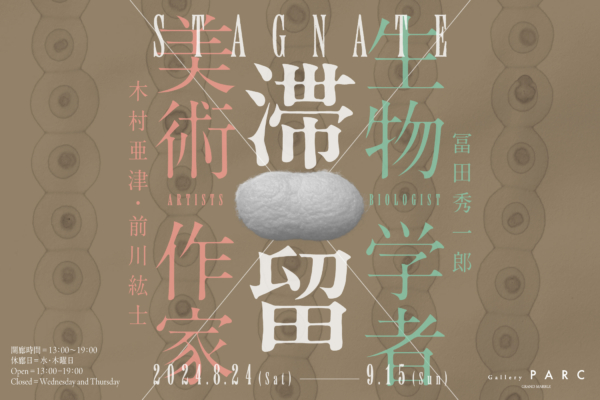開催情報
【作家】木村亜津・冨田秀一郎・前川紘士
【期間】2024年8月24日(土) ─ 2024年9月15日(日)
【開館時間】13:00-19:00
【休館日等】水・木曜
【料金】無料
https://www.galleryparc.com/pages/exhibition/ex_2024/2024_0824_stagnate.html
会場
会場名:Gallery PARC
webサイト:https://galleryparc.com/index.html
アクセス:〒602-8242 京都府京都市上京区皀莢町(サイカチチョウ)287 堀川新文化ビルヂング 2階
電話番号: 075-334-5085
概要
「滞留」は、美術作家の木村亜津と前川紘士、生物学者の冨田秀一郎による自主企画展です。本企画のメンバーは、2021年からの3年間、科学者と美術作家の交流を促すプログラム「ファンダメンタルズ プログラム」に参加した際に出会い、木村と冨田、前川と冨田のそれぞれがペアを組み、個別に交流を重ねてきました。交流のペースや内容はそれぞれのペアで異なりますが、手探りのやり取りの中から少しずつ他者と共有できる/してみたいと思う断片が生まれて来ています。
展覧会タイトルの「滞留」とは、本企画を表す言葉として3者が共通して適っていると捉えた言葉です。英語に訳した“STAGNATE”には、”停滞”や”淀み”といったネガティブな印象を与える意味もありますが、元の流れから一旦距離を取り、アイディアやイメージを漂わせることは、新たな想像や実践を育む機会にも繋がります。本展では、それぞれの交流から生まれたものを来場者と共有すると共に、通常のスピードでは流れ過ぎて行ってしまうものを一時的に留め、留まったもの同士の邂逅や新たな相互作用が生まれる事を期待しています。
Statement
私の世界を球とした場合、私は対象と向き合った時に円が重なる場所はどこだろう、重ならなくても触れる接点のような場所はどこだろうと考えます。対象を俯瞰で見たり、ぐっと距離を縮めるなどして観察を行い、また同時に、作品として形にすることで接点を探ってきました。今回の対象は昆虫であると同時に生物学者の冨田さんでもあり、どうすれば彼らと接することができるかを、実践的かつ具体的な方法で探ってみました。
木村亜津
私たちが様々な生命現象と向き合ったときには、あらゆる階層で「擬人化」をして理解しようとすることに気づいた時に、私には「他の生物と意思疎通ができるのか(出来るとすればどうやって)」という根源的な問いが生まれました。しかしながら芸術家の皆さんとの交流を通じて感じたのは、人間同士でもその手段·方法は必ずしも保証されない、ということでした。開き直って全ての生物わけへだてなく「感覚共有幻想」として楽しむことにしました。
冨田秀一郎
生物学者の冨田さんとの交流は、お互いの「捉え難さ」が、出発点であると同時に交流に取り組む際の動機でもありました。様々な方法を通して、お互いの興味が動くポイントを探す”炙り出し作業”を続けています。 今回は、これまでの交流の中で、言葉を用いずに行った”もの”のやりとり「模型の交換」を並べます。また、身の回りの生き物についての記述の整理やアプローチをこの機に進め、今後の活動に還元出来る経験を増やしたい、と考えています。
前川紘士
About
“STAGNATE” is an independent exhibition by artists Azu Kimura, Koji Maekawa, and biologist Shuichiro Tomita. The project is an ongoing culmination of works during their participation in the Fundamentalz program, which has promoted exchanges between scientists and artists since 2021.
Artists Kimura and Maekawa have collaborated with Biologist Tomita on their individual investigations. Through these discussions, they have made different approaches and discoveries, gradually accumulating fragments that can be shared with others.
The exhibition, titled “STAGNATE,” encompasses the ideas and thoughts of the participants.
It will showcase the detritus of research and thoughts accumulated throughout the meetings between artists and biologists.
Whilst these fragmentary moments flow past us unnoticed, In our exhibition, we hope for these works to ignite unexpected interactions and responses from visitors, generating a growing synergy of ideas, works and encounters.
Statement
If the elements of our world were represented as individual spheres, how do these circles interconnect when I encounter a new subject? Even if the circles seem unrelated, I wonder where I can build points of connection. I have been seeking the point of contact by observing and contrasting subjects from both a bird’s eye and microscopic viewpoint, and at the same time, giving these discoveries shape through art. This collaboration with Biologist, Dr. TOMITA brought upon a new challenge. My subject was insects, but also the understanding and bridging of our differing perspectives to inform my new works. This time, my subjects are insects. Working with biologists, I tried to find a practical and tangible means to respond to our differing perspectives.
Kimura Azu
When we face various biological phenomena, we tend to anthropomorphise at every level to understand them. This led me to a fundamental question: “Can we communicate with other living beings (and if so, how)?” However, through interactions with artists, I realised that even among humans, such means and methods are not always guaranteed. So, I decided to embrace the fantasy of “shared sensation” without discrimination among all living beings.
Tomita Shuichiro
During our exchange with Dr. Tomita who is a biologist, our mutual regard for “elusiveness” was both a starting point and a motivation for engaging in exchange. Through various ways, we continue to search for points that spark interest in both of us. This time, we will create an opportunity to display and share the non-verbal exchange of models inspired by our interactions. And also throughout three years I have been gradually recording the living things we find around us. I want to take this opportunity to organize these collected records, as a means to apply these experiences in future practices.
Maekawa Koji
